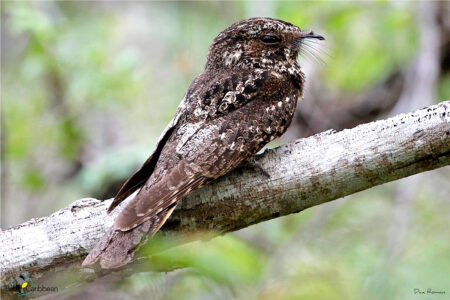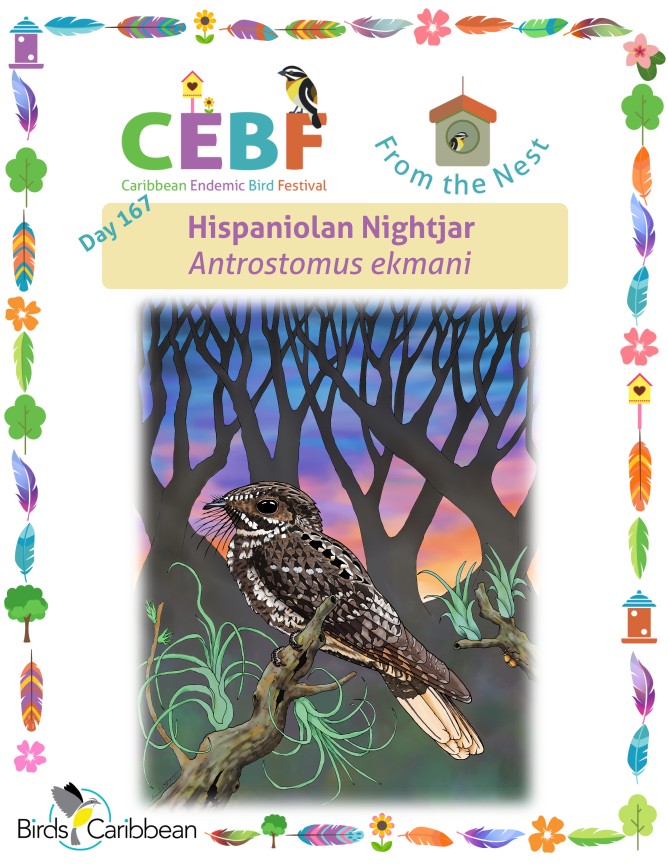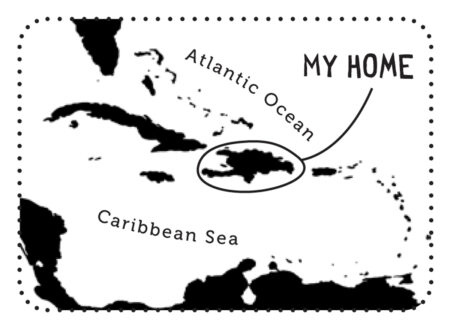Celebrate the Caribbean Endemic Bird Festival (CEBF) with us! Our theme in 2025 is “Shared Spaces: Creating Bird-friendly Cities and Communities”—highlighting the crucial role bird-friendly cities and communities can have in addressing the decline in bird populations caused by threats like habitat loss, predation, and climate change. Have fun learning about a new endemic bird every day. We have colouring pages, puzzles, activities, and more. Download for free and enjoy learning about and celebrating nature!
Endemic Bird of the Day: Hispaniolan Nightjar
If you ever find yourself walking through the forests of Hispaniola at night, listen closely. A ghostly call—pi-tan-guaaaa—echoes through the trees. This mysterious sound belongs to the Pitanguá, or Hispaniolan Nightjar, a bird so elusive that many locals recognize its voice but have never seen it.
The Hispaniolan Nightjar is a master of camouflage. Its mottled dark brown and grayish plumage blends perfectly with the leaf-strewn forest floor. Males can be distinguished by the white tips on their outer tail feathers, while females have buff-colored tips. Its cryptic coloration and nocturnal habits make it one of the most difficult birds to observe in the wild.
Endemic to Hispaniola, this nightjar favors mid-elevation forests in the Dominican Republic, especially in the Cordillera Central, Sierra de Bahoruco, and Loma de Cabrera. It is typically found between 300 and 750 meters above sea level, often in broadleaf forest. While its current status in Haiti today is uncertain, historical records indicate it was once more widespread across the island.
LIttle is known about tis diet, but like other nightjars, A. ekmani is an aerial insectivore. With a wide, bristle-lined mouth, it catches insects on the wing, feeding almost exclusively at night.
Its distinctive call—a prolonged pi-tan-guaaaa—is repeated throughout the night and inspired its local name. The sound carries throughout the forest and is often described as haunting or mournful, contributing to the bird’s near-mythical reputation. According to local legend, the Pitanguá’s song is believed to be the voice of wandering spirits calling out through the night forest.
The Pitanguá nests directly on the ground, laying two greenish-white eggs with brown blotches in a shallow depression hidden among the leaves. Breeding occurs from April to July, and the species relies on its excellent camouflage to avoid predators. Without a constructed nest, the eggs’ survival depends on how well-hidden they are.
BirdLife International currently considers its population trend to be stable. However, the Pitanguá has suffered significant declines due to habitat destruction and invasive species. Deforestation—especially in Haiti—has severely reduced its breeding range. Like many nocturnal birds, it is also sometimes persecuted due to superstition. More research is needed to determine its current status in Haiti and to monitor remaining populations in the Dominican Republic.
The Hispaniolan Nightjar remains one of the island’s most mysterious birds—rarely seen, but often heard. With continued conservation efforts—and a bit of luck—future generations will still hear its eerie, beautiful pi-tan-guaaaa echoing through the night. Learn more about this species, including its range, photos, and calls here. Great news! If you’re in the Caribbean, thanks to BirdsCaribbean, you have free access to Birds of the World and you can find out even more in the full species account of this bird!
Thanks to Arnaldo Toledo for the illustration and Elvin Vargas Esévez for the text!
Colour in the Hispaniolan Nightjar
Download our West Indies Endemic Bird colouring page. Use the photos below as your guide, or you can look up pictures of the bird online or in a bird field guide if you have one. Share your coloured-in page with us by posting it online and tagging us @BirdsCaribbean #CEBFfromthenest
Listen to the song of the Hispaniolan Nightjar
The song of the Hispaniolan Nightjar a burry “pit, whoo-vore?” often repeated.
Puzzle of the Day
Click on the image below to do the puzzle. You can make the puzzle as easy or as hard as you like – for example, 6, 8, or 12 pieces for young children, all the way up to 1,024 pieces for those that are up for a challenge!


Activity of the Day
 FOR KIDS : Birds like the Hispaniolan Nightjar are very good at hiding in plain sight. Their colours help them to blend in with their environment. Insects also use camouflage to blend in with their environment and keep them safe from other animals that love munching on them. But note that it also helps some insects catch prey that doesn’t see them! Their colours, patterns and even physical shape make them indistinguishable from their surroundings.
FOR KIDS : Birds like the Hispaniolan Nightjar are very good at hiding in plain sight. Their colours help them to blend in with their environment. Insects also use camouflage to blend in with their environment and keep them safe from other animals that love munching on them. But note that it also helps some insects catch prey that doesn’t see them! Their colours, patterns and even physical shape make them indistinguishable from their surroundings.
In this activity you’re going to go outside (with an adult) and help insects and birds find the best spot for them to blend in such as in the grass, amongst fallen leaves, branches, leaves, flowers, dirt, tree trunks, and other plants.
You will need:
- pencil
- scissors
- clipboard (optional)
- copy of Masters of Camouflage page
Can you find the ‘Masters of Camouflage’ page to print (in colour or black and white) and full instructions of this activity here!
FOR KIDS AND ADULTS : Enjoy this video about why Hispaniolan Nightjar was made a seperate species!


